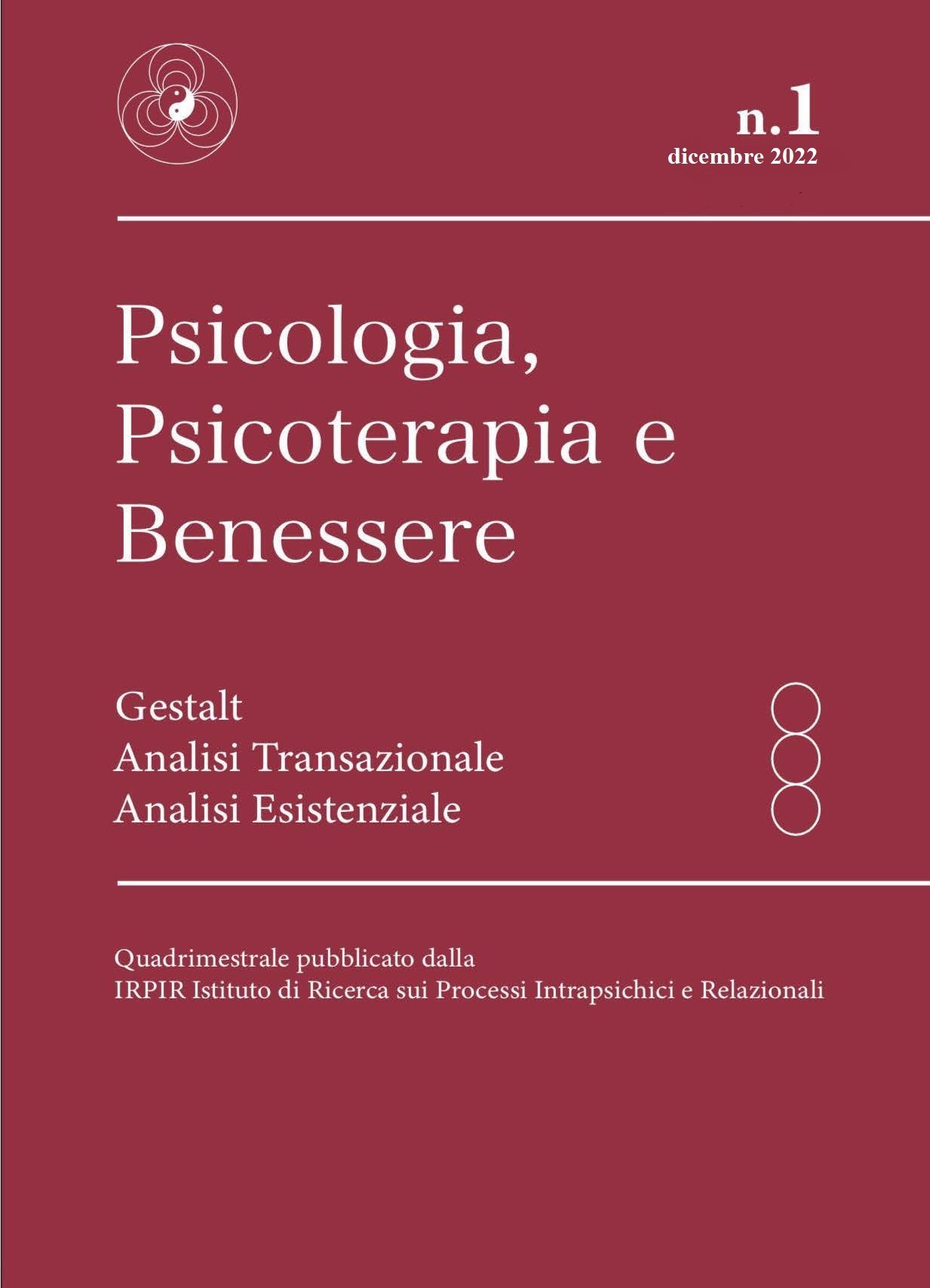The complex relational trauma in the light of the polyvagal theory: the transformative power of feeling safe
Keywords:
Relational trauma, Polyvagal theory, Transformative powerAbstract
What is pointed out in this article, based on polyvagal theory as a reference, is how a greater understanding of the autonomic nervous system functioning, as well as the neuropsychological substrates respon-sible for emotional experiences and affective processes, which are essen-tial for social behavior, can help understand traumatized patients and support the way to approach them.
It will be highlighted that sometimes the physiological state, if not well-regulated and managed after experiencing a trauma, can limit both the field of behavior and psychological experience of individuals, because the extent of the trauma may have been so destabilizing that it influences future experiences preventing the individual from feeling safe again.
Finally, the emphasis will be placed on the therapeutic impor-tance of creating a safe environment in order to favor the strengthening of the myelinated vagus circuit linked to social involvement, which is of-ten inhibited in traumatized patients.
References
ACCURSIO, G., BUCOLO, G. (2007). Psicologia del profondo. Modelli e tecniche di psicoterapia psicodinamica. Milano: Franco Angeli.
AMMANITI, M., GALLESE, V. (2014). La nascita dell’intersoggettività: lo sviluppo del sé tra psicodinamica e neurobiologia. Milano: R. Cortina.
BALDINI, C. (2011). Metodo Med. Movimento evolutivo dinamico. Appunti per la formazione. Milano. Diapositive in <http://www.teatrodanzamed.com/www.teatrodanzamed.com/Vuoto_5_files/1)%20Q3-1.pdf> (21.11.2017), 1-63.
BERTUZZI, A. (2014). La Teoria Polivagale su Attac-camento e Trauma (2014) – Report dal Congresso. State of mind. In <http://www.stateofmind.it/2014/09/attaccamento-trauma-2014-liotti-porges/> (21.11.2017).
BORGOGNO, F., CASSULLO, G. (2011). Le molte fac-ce del trauma. Roma: Borla.
BREEDLOVE, S. M., ROSENZWEIG, M. R., WATSON, N. V. (2009). Psicologia biologica. Introduzione alle neuro-scienze comportamentali, cognitive e cliniche. (3. ed.). Milano: Ambrosiana.
CAMPLONE, S. (2016). Trauma e neurocezione. In <http://www.medicitalia.it/blog/psicologia/6805-trauma-neurocezione.html> (21.11.2017).
CHELI, M. (s.a.). Il Trauma Complesso: primi studi epi-demiologici sulle conseguenze nello sviluppo. In (26.11.2017), 1-9.
CHELI, M., GAMBUZZA, C. (2017). Il disturbo post traumatico complesso. Dalla teoria alla pratica multidisciplina-re. Milano: FrancoAngeli.
COZOLINO, L. (2008). Il cervello sociale. Neuroscienze delle relazioni umane. Milano: Raffaello Cortina.
D’AMBROSIO, M. (2017). Balbuzie e cluttering. Le nuove prospettive. Milano: FrancoAngeli.
EMDR ITALIA. (s.a.). Trauma. Cosa si intende per trauma psicologico? In <http://emdr.it/index.php/trauma/> (03.04.2018).
ERBA, M. (2016). La teoria polivagale. Con la teoria polivagale, Stephen Porges chiarisce il ruolo del sistema nervo-so autonomo nei disturbi post-traumatici. In <http://martaerba.it/la-teoria-polivagale/> (02.04.2018).
FIORE, F. (2017). Il neurone: l’anatomia e i diversi tipi della cellula nervosa – Introduzione alla psicologia. State of mind. In <http://www.stateofmind.it/2017/04/neurone-introduzione-psicologia/> (06.05.2018).
FONAGY, P., TARGET, M. (1998). An interpersonal view of the infant in HURRY, a (Ed.), Psychoanalysis and Deve-lopmental Therapy. Londra: Karnac Books, 3-31.
GELLER, S. M., PORGES, S. W. (2014). Therapeutic Presence: Neurophysiological Mechanisms Mediating Feeling Safe in Therapeutic Relationships. Journal of Psychotherapy Integration, 24 (3), 178-192.
GOVERNATORI, C. (2015). Trauma Relazionale Pre-coce: i Pericoli dei Traumi Nascosti. In <http://www.igorvitale.org/2015/10/01/trauma-relazionale-precoce-i-pericoli-dei-traumi-nascosti/> (21.11.2017).
HOWES, R. (2013). Wearing your heart on your face. The polyvagal circuit in the consulting room. In <https://www.psychotherapynetworker.org/> (27.11.2017), 67-70.
IACCARINO, S. (s.a.). L’importanza di sentirsi al sicuro – seconda parte. In <http://percorsiformativi06.it/limportanza-di-sentirsi-al-sicuro-seconda-parte/> (26.09.2018).
ISTITUTO DI SCIENZE COGNITIVE. (2014). Congres-so attaccamento e trauma. Atti del congresso di Roma 19-20-21 settembre 2014.
LIOTTI, G. (2005). Trauma e dissociazione alla luce del-la teoria dell’attaccamento. Infanzia e adolescenza, 4 (3), 130-144.
MARZOCCHI, C. (2014a). Intervista con Stephen Por-ges: La Teoria Polivagale e le basi fisiologiche delle nostre intui-zioni. State of mind. In <http://www.stateofmind.it/2014/12/stephen-porges-intervista-teoria-polivagale/> (21.11.2018).
NCTSN (National Child Traumatic Stress Network). (2003). Complex Trauma in Children and Adolescents. White Paper from the National Child Traumatic Stress Network Com-plex Trauma Task Force. In <http://www.nctsnet.org/> (21.11.2018), 1-41.
PORGES, S. W. (2003a). La teoria Polivagale: contribu-ti filogenetici al comportamento sociale. In <http://www.terapiacognitiva.eu/cpc/dwl/polivagale/articolo-cs.pdf> (21.11.2018), 1-26.
PORGES, S. W. (2014). La teoria polivagale. Fonda-menti neurofisiologici delle emozioni, dell’attaccamento, della comunicazione e dell’autoregolazione. Roma: Giovanni Fioriti.
SANDER, L. (1962). Issues in early mother-child inte-raction. In <http://www.jaacap.com/issue/S0002-7138(09)X6001-2> (17.04.2018), 141-166.
SIEGEL, D. J. (2013). La mente relazionale. Neurobio-logia dell’esperienza interpersonale. (2.ed.). Milano: Raffaello Cortina.
TAGLIAVINI, G. (2011). Modulazione dell’arousal, memoria procedurale ed elaborazione del trauma: il contributo clinico del modello polivagale e della psicoterapia sensomotoria. Cognitivismo clinico, 8 (1), 60-72.
TAYLOR, M. (2016). Psicoterapia del trauma e pratica clinica. Corpo, neuroscienze e Gestalt. Milano: FrancoAngeli.
TRESOLDI, M. (2017). La teoria polivagale di Porges. In <http://www.oloselogos.it/wp-content/uploads/2017/12/La-teoria-polivagale.pdf> (30.03.2018), 1-5.
VAN DER KOLK, B. (2014). Prefazione in PORGES, S., La teoria polivagale. Fondamenti neurofisiologici delle emozio-ni, dell’attaccamento, della comunicazione e dell’autoregolazione. Roma: Giovanni Fioriti, XV- XXII.
VAN DER KOLK, B. (2015). Il corpo accusa il colpo. Mente, corpo e cervello nell’elaborazione delle memorie trau-matiche. Milano: Raffaello Cortina.
WAGNER, D. (2016). Polyvagal theory in practice. Counseling Today, 50-53. In <http://ct.counseling.org/2016/06/polyvagal-theory-practice/> (27.10.2018).
WILLIAMS, R. (2009). Trauma e relazioni. Le prospet-tive scientifiche e cliniche contemporanee. Milano: Raffaello Cortina.
WINNICOTT, D., W. (1965). Sviluppo affettivo e am-biente: studi sulla teoria dello sviluppo affettivo, trad. it Roma: A. Armando. 1994.
Sitografia
La Neurologia dell’Attaccamento in <http://www.unabasesicura.it/teorie-03-neurologia.html> (21.10.2018).
Teoria Polivagale di Porges e Sistema di Difesa nei traumi in <https://www.psicologo-mantova.net/blog/teoria-polivagale-di-porges-e-sistema-di-
Downloads
Published
How to Cite
Issue
Section
License

This work is licensed under a Creative Commons Attribution-NonCommercial 4.0 International License.






